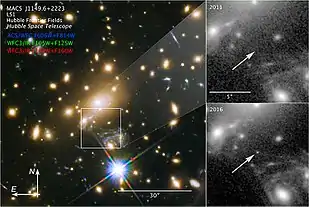K2-155d
K2-155d is a potentially habitable Super-Earth exoplanet in the K2-155 system.[3] It is the outermost of three known planets orbiting around the K-type star K2-155 in the constellation Taurus.[4] It is one of 15 new exoplanets around red dwarf stars discovered by Japanese astronomer Teruyuki Hirano of the Tokyo Institute of Technology and his team.[5] The team used data from NASA's Kepler Space Telescope during its extended K2 "Second Light" mission. K2-155d orbits near the so-called habitable zone of its system, and has the potential to host liquid water.[6][3]
| Discovery | |
|---|---|
| Discovered by | Teruyuki Hirano |
| Discovery site | Tokyo Institute of Technology |
| Discovery date | March 2018 |
| Transit method | |
| Orbital characteristics | |
| 0.1886 (± 0.0066)[1] AU | |
| Eccentricity | unknown |
| 40.6835 (± 0.0031)[1] d | |
| Inclination | unknown |
| Star | K2-155 |
| Physical characteristics | |
Mean radius | 1.64 +0.18 −0.17[1] R⊕ |
Mean density | 5.41 ± 1.11 kg/m3 (9.12 ± 1.87 lb/cu yd) |
| Temperature | 289 K (16 °C; 61 °F)[2] |
Discovery and observations
K2-155d is one of 15 exoplanets discovered by a team of Japanese astronomers led by Teruyuki Hirano at the Tokyo Institute of Technology.[3] Its discovery is based on data from the K2 mission of NASA's Kepler spacecraft.[3] The exoplanet has also been observed from ground-based telescopes including the Nordic Optical Telescope (NOT) in La Palma and the Subaru Telescope in Hawaii.[3] Its characteristics were confirmed using speckle imaging and high-dispersion optical spectroscopy.[1] The mass of K2-155d and the brightness of its host star may be measured by future observations from the W. M. Keck Observatory and the James Webb Space Telescope.[1] The brightness of its host star makes K2-155d a good target for future studies using instruments such as the James Webb Space Telescope.[1]
Characteristics
K2-155d is a super-Earth exoplanet with a radius 1.64 times that of Earth, near the transition zone between small rock-based and larger gaseous planets.[7][1][6] Climate models predict that it is located near its star's habitable zone and has an insolation 1.67 ± 0.38 (between 1.29 and 2.05) times that of Earth.[1] Its physical temperature is estimated to be 289 K (16 degrees Celsius or 61 degrees Fahrenheit).[2] Studies have shown that the planet would maintain a moderate surface temperature if its insolation is smaller than ∼1.5 times that of Earth.[1]
K2-155d is one of three known planets in the system orbiting K2-155, a red dwarf star located 200 light years from Earth. Its parent star has 88% less volume than the Sun.[8] K2-155d orbits its star with a 40.7 day period, but as the planet is tidally locked the same side always faces its sun.[3] K2-155d has an orbital radius of 0.1886 AU[7] and studies suggest that the planet has a low orbital eccentricity.[9]
Potential habitability
K2-155d has been labeled a potentially habitable planet that may be able to harbor liquid water.[6][3] A three-dimensional climate simulation was used to confirm the possibility of the existence of water.[3] However, its discoverer Teruyuki Hirano was cautious about the findings, stating that they do not guarantee K2-155d is habitable, as the ranges in its orbit and temperature allow the possibility of it being outside the habitable zone.[6] Factors such as the absence of solar flares could also decide if K2-155d is habitable.[3]
References
- Hirano, Teruyuki; et al. (March 2018). "K2-155: A Bright Metal-poor M Dwarf with Three Transiting Super-Earths". The Astronomical Journal. 155 (3): 11. arXiv:1801.06957. Bibcode:2018AJ....155..124H. doi:10.3847/1538-3881/aaaa6e. 124.
- "HEC: Exoplanets Calculator (K2-155d)". Planetary Habibility Laboratory.
- Mack, Eric (March 13, 2018). "A super-Earth around a red star could be wet and wild". CNET.
- "K2-155 PLANET HOST OVERVIEW PAGE". NASA Exoplanet Archive.
- "15 new planets confirmed around cool dwarf stars". Tokyo Tech News. March 12, 2018.
- Dovey, Dana (March 14, 2018). "Super Earth 200 Light-Years Away May Hold Ideal Temperatures For Liquid Water And Life". Newsweek.
- "Confirmed Planet Overview Page: K2-155d". NASA Exoplanet Archive. 2018.
- "K2-155d". Exoplanet Data Explorer. 2018.
- Eylen, Vincent; Albrecht, Simon (May 11, 2015). "Eccentricity from transit photometry: small planets in Kepler multi-planet systems have low eccentricities". The Astrophysical Journal. 808 (2): 126. arXiv:1505.02814. Bibcode:2015ApJ...808..126V. doi:10.1088/0004-637X/808/2/126.

